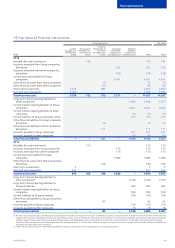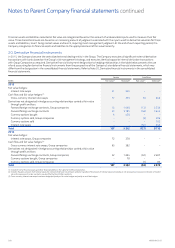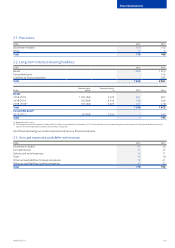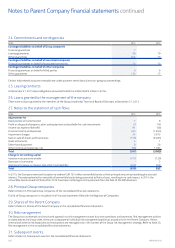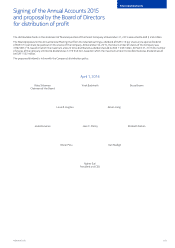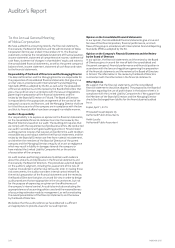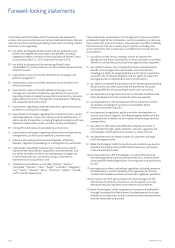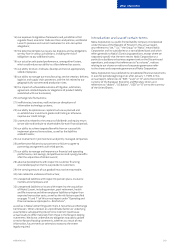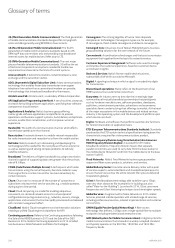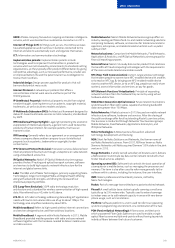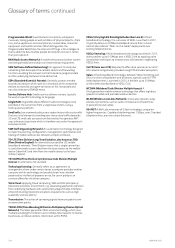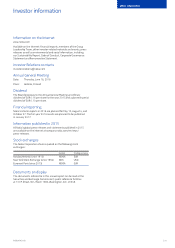Nokia 2015 Annual Report Download - page 211
Download and view the complete annual report
Please find page 211 of the 2015 Nokia annual report below. You can navigate through the pages in the report by either clicking on the pages listed below, or by using the keyword search tool below to find specific information within the annual report.
209
Other information
NOKIA IN 2015
HERE: A Nokia company focused on mapping and location intelligence
services, which was divested to an automotive consortium in 2015.
Internet of Things (IoT): All things such as cars, the clothes we wear,
household appliances and machines in factories connected to the
Internet and able to automatically learn and organize themselves.
ICT: Information and communications technology.
Implementation patents: Implementation patents include
technologies used to implement functionalities in products or
serviceswhich are not covered by commitments to standards setting
organizations, so they typically oer product dierentiation by giving
competitive advantage, such as increased performance, smaller size
orimproved battery life and the patent owner has no obligation to
license them to others.
Industrial design: Design process applied for products that will
bemanufactured at mass scale.
Internet Protocol: A network layer protocol that oers a
connectionless internet work service and forms part of the
TCP/IP protocol.
IP (Intellectual Property): Intellectual property results from original
creative thought, covering items such as patents, copyright material,
trademarks, as well as business models and plans.
IP Multimedia Subsystem (IMS): Architectural framework designed to
deliver IP-based multimedia services on telco networks; standardized
by 3GPP.
IPR (Intellectual Property Right): Legal right protecting the economic
exploitation of intellectual property, a generic term used to describe
products of human intellect, for example patents, that have an
economic value.
IPR licensing: Generally refers to an agreement or an arrangement
where a company allows another company to use its intellectual
property (such as patents, trademarks or copyrights) under
certainterms.
IPTV (Internet Protocol Television): Television services delivered over
Internet protocol infrastructure through a telephone or cable network
using a broadband access line.
IP/Optical Networks: Nokia’s IP/Optical Networks business group
provides the key IP routing and optical transport systems, software
and services to build high capacity network infrastructure for the
internet and global connectivity.
Labs: The R&D unit of Nokia Technologies, primarily supporting Nokia
Technologies’ longer-term Digital Media and Digital Health oering
along with advanced concepts, and driving the renewal of our
intellectual property portfolio.
LTE (Long-Term Evolution): 3GPP radio technology evolution
architecture and a standard for wireless communication of high-speed
data. Also referred to as 4G, refer to 4G above.
LTE-M: An IoT radio technology addressing demanding IoT applications
needs with low to mid-volume data use of up to about 1Mbps. The
technology also simplies modems by about 80%.
Mobile broadband: Refers to high-speed wireless internet connections
and services designed to be used from arbitrary locations.
Mobile Broadband: A segment within Nokia Networks in 2015. Mobile
Broadband provided mobile operators with radio and core network
software together with the hardware needed to deliver mobile voice
and data services.
Mobile Networks: Nokia’s Mobile Networks business group oers an
industry-leading portfolio of end-to-end mobile networking solutions
comprising hardware, software, and services for telecommunications
operators, enterprises, and related markets/verticals such as public
safety and IoT.
Networks business: Comprises the Mobile Networks, Fixed Networks,
Applications & Analytics, and IP/Optical Networks business groups for
nancial reporting purposes.
Nokia Airframe: Nokia’s 5G-ready data center product that combines
the benets of Cloud computing technologies with the requirements
of the core and radio telecommunications world.
NFC (Near Field Communication): A short-range wireless technology
that enables people to connect one NFC-enabled device with another,
or to read an NFC tag. By bringing one NFC-enabled mobile device
close to another NFC device, or to an NFC tag, people can easily share
content, access information and services, or pay for goods.
NFV (Network Functions Virtualization): Principle of separating
network functions from the hardware they run on by using virtual
hardware abstraction.
NGOA (Next Generation Optical Access): Future telecommunications
system based on ber optic cables capable of achieving bandwidth
data rates greater than 100 Mbps.
Nokia Networks: A Nokia business in 2015 focused on mobile network
infrastructure software, hardware and services. After the closing of
thepublic exchange oer for all outstanding Alcatel Lucent securities,
thisbusiness is conducted through Networks’ four business groups:
Mobile Networks, Fixed Networks, Applications & Analytics, and
IP/Optical Networks.
Nokia Technologies: A Nokia business focused on advanced
technology development and licensing.
NSN: Short for Nokia Solutions and Networks, the former name of
ourNokia Networks business. From 2007, NSN was known as Nokia
Siemens Networks until Nokia acquired Siemens’ 50% stake in the joint
venture in 2013.
Nuage Networks: A wholly owned subsidiary of Alcatel Lucent, delivers
a SDN solution to eliminate key data center network constraints that
hinder Cloud services adoption.
Operating system (OS): Software that controls the basic operation of
a computer or a mobile device, such as managing the processor and
memory. The term is also often used to refer more generally to the
software within a device, including, for instance, the user interface.
OZO: Nokia’s professional Virtual Reality camera, crafted by
NokiaTechnologies.
Packet: Part of a message transmitted over a packet switched network.
Picocell: A small cellular base station typically covering a small area
typically up to 200 meters wide. Typically used to extend coverage
toindoor areas or to add network capacity in areas with very dense
phone usage, such as train stations.
Platform: Software platform is a term used to refer to an operating
system or programming environment, or a combination of the two.
PON (Passive Optical Networking): A ber access architecture in
which unpowered Fiber Optic Splitters are used to enable a single
optical ber to serve multiple end-points without having to provide
individual bers between the hub and customer.


